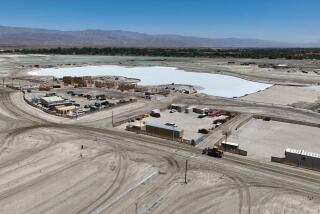Ice Age fossils unearthed at Carlsbad construction site
reporting from CARLSBAD, Calif. — A trove of Ice Age fossils has turned up at a construction site here where hundreds of new homes are planned south of California 78.
Bones of ancient mammoths, horses, turtles and even a prehistoric bison — the second ever found in San Diego County — have been unearthed at the site, said Tom Deméré, curator of paleontology at the San Diego Natural History Museum.
All the fossils are from the Pleistocene Epoch and are 50,000 to 200,000 years old.
“It’s really an exciting project in terms of the geology and paleontology,” Deméré said.
“The fossils have the potential to tell us a great deal about the climate, the environment, the ecology of that time when they were living,” he said. “They are direct connections with the past, an ancient ecosystem that was once common here. We can understand how climates can change by studying these ancient ecosystems.”
The bones were discovered after grading began this summer at the Quarry Creek development site, which covers about 60 acres between College Boulevard and El Camino Real. The Carlsbad City Council approved plans for the new homes in 2013 after a long and contentious community debate. The original developer, Corky McMillin Cos., trimmed the proposed subdivision to a maximum of 636 units — mostly apartments and condominiums — before selling it to San Diego-based Cornerstone Communities.
Major construction projects in California are required to have a paleontologist on site when large amounts of earth are moved. Still, John Suster, Cornerstone’s project superintendent in Carlsbad, said he was surprised when the first fossils were unearthed in July. Work was temporarily halted while the scientists excavated the site.
“I said, ‘Take your time, this is kind of cool,’” Suster said.
On Thursday, he pointed out the freshly smoothed area where the largest mammoth bone was found.
“It’s just rolling hills, nothing special,” Suster said. “I don’t think there’s any way you could have known.”
Cornerstone Chief Executive Ure Kretowicz said Wednesday that his company has worked closely with paleontologists throughout the grading, which is expected to continue for two more months.
When a possible fossil is found, it is cordoned off and work stops within that area as paleontologists move in.
“They do a [plaster] cast in place, and then remove it,” Kretowicz said. “We stop everything or go grade another area on the site. Once they’re gone, we start up again.”
The bison fossil, which includes a skull and partial skeleton, is the most unusual and probably the most complete of the larger animals found at the site, Deméré said. The exact species hasn’t been identified, but researchers believe it is either a giant bison or an antique bison.
“These are big animals, much larger than modern plains bison,” he said.
The specimen has been moved to the museum and is being carefully removed from its plaster jacket. It will eventually be placed on temporary display at the museum, but its final home has not been decided.
The only other bison fossil ever found in San Diego County was discovered about three years ago at a Caltrans construction site near Pala. That one was a giant bison, which paleontologists said probably measured up to 8 feet tall at the shoulders, 15 feet from tail to nose, and weighed as much as 2 tons.
The fossils found in Carlsbad include at least two Columbian mammoths, an animal larger than the better-known woolly mammoths that lived in the northern latitudes of North America. Columbian mammoths stood 13 feet tall at the shoulders and weighed 8 to 10 tons.
Mammoth bones or tusks have previously been found at construction sites in downtown San Diego, Oceanside, Fairbanks Ranch and the Colorado Desert.
An experienced paleontologist can look at a site like Quarry Creek and know where fossils are most likely to be found, Deméré said.
“You can see that it’s actually layered sediment,” he said. “It’s like pages in a book. You could call the title ‘The History of the Planet Earth.’”
Much of the Quarry Creek site is in a low area crossed by the Buena Vista Creek.
More small fossils could still turn up in the sediment that paleontologists have collected with the large pieces, Deméré said.
The fossils are similar to a smaller collection found a few years ago at a construction site near a driving range just west of the Quarry Creek project, he said. Those fossils were more fragmentary and did not include a bison, he said, but they did include the bones of an ancient camel.
“We are excited to see this one,” Deméré said. “It shows us how dynamic the earth can be.”
Construction on the Quarry Creek development is scheduled to begin early next year on 88 two-story row homes, in the first of four planned neighborhoods. The first units could be ready by the end of 2016.
Phil Diehl writes for the San Diego Union-Tribune.
ALSO:
Hazardous surf conditions predicted for Labor Day weekend
After 91 years, flying fish but no plying boat as the Blanche W ends its Catalina Island run
Dispute over Escondido golf course land turns into a smelly mess
More to Read
Sign up for Essential California
The most important California stories and recommendations in your inbox every morning.
You may occasionally receive promotional content from the Los Angeles Times.










